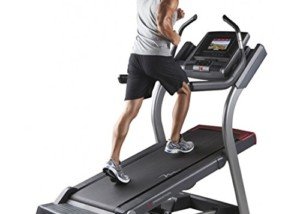
Treadmills these days come with all sorts of viewing screens, ranging from Netflix to interactive training. Should you hold on while viewing?
The instinct is to hold on while viewing a TV screen while walking and especially jogging on a treadmill.
Did the human body evolve to watch a screen while walking? Our ancient ancestors certainly did no such thing.
However, our ancient ancestors also didn’t hold onto anything while they trekked for miles on a daily basis.
If you’re serious about achieving your goals – whether they be fat loss, more stamina, improved cardiovascular health and/or a reduced risk of disease such as type 2 diabetes and high blood pressure – you absolutely should NOT hold onto a treadmill – other than for momentary balance checks such as when changing a setting, looking at someone or drinking water.
So even if you’re viewing an exciting movie or engaging in an interactive incline workout, your body should be moving naturally with an arm swing.
The arm swing need not be dramatic, but certainly, you should not be holding onto the treadmill, either.
Of course, we did not evolve to “walk” on a perfectly flat, perfectly smooth, moving motorized surface.
This is all the more reason, though, that we should walk or jog as naturally as possible while on a treadmill.
By freeing up our hands, an optimized posture is encouraged. The function of the core (soft tissue in the lower back and abdominal region) is to keep us upright and stabilize the spinal column.
If you hold onto a treadmill, you take this job away from the core. Do you really want to deprive these muscles from doing what they were designed to do while you walk?
Watch people who hold onto a treadmill. You’ll note in many cases they have poor posture. They’re slumped forward. Their hips are over-rotating. They have a hard foot strike. Their shoulders bob funny. These are all the result of holding onto the treadmill.
Falling off While Viewing a TV Screen on a Treadmill
Do you feel that you’ll slip off if you let go? Then follow these guidelines.
• Set the speed at a slow pace. Do not get ahead of yourself.
• Allow your body to get used to walking on a moving surface while you watch a screen.
• If this means only 1 mph, then go only 1 mph. Then gradually increase speed as your body adjusts.
• Same with an incline: Don’t put it high at first. Start out with maybe five percent.
• If you feel that you can’t let go, then either the speed is too fast or the incline is too high.
• Keep in mind that the higher the incline, the more your lower back muscles will be called into action – as long as you’re not holding on. Walking hands-off at an incline will have a great training effect on those lower back muscles.
What if an interactive program shows a person holding on?
There could be several reasons why the person or instructor in the video is holding on.
The main reason may be to appeal to as many people as possible. A video of someone holding on will have more appeal to those who aren’t very confident when it comes to structured exercise.
If the instructor is holding on, this is more likely to make a potential user think, “Gee, I can do that.”
Another reason is that the people behind the video don’t realize how sabotaging holding onto a treadmill really is.
Another reason is for liability. The manufacturer doesn’t want to take a chance that a user, who falls off and injures their back, then sues them by claiming, “Nobody in the video was holding on, so I thought it was safe not to hold on.”
Of course there’s always a risk of slipping and falling. You also have this risk when walking outdoors where there’s nothing to hold onto.
You might get in a car accident on the way to the store to buy healthful food. Life is full of risks.
This doesn’t mean you should employ incorrect walking technique that can disrupt gait or cause a repetitive stress injury in your hips which are forced to move unnaturally when your upper body is locked up by holding onto the machine!
Quite frankly, it’s exceedingly rare to fall off a treadmill while walking with free hands – unless you turn around to greet someone or become distracted by a dog outside the window or some other environmental stimulus that compromises awareness of your body moving in space. This is why I said earlier that you should hold on for momentary balance checks.
 Lorra Garrick has been covering medical, fitness and cybersecurity topics for many years, having written thousands of articles for print magazines and websites, including as a ghostwriter. She’s also a former ACE-certified personal trainer.
Lorra Garrick has been covering medical, fitness and cybersecurity topics for many years, having written thousands of articles for print magazines and websites, including as a ghostwriter. She’s also a former ACE-certified personal trainer.
.


























